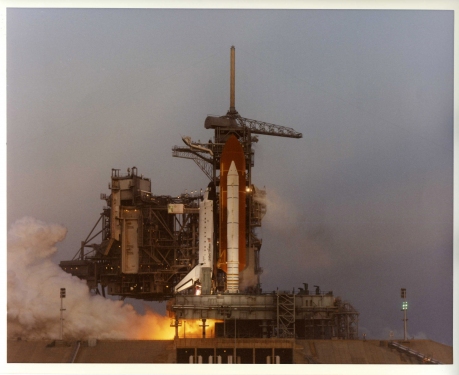
In the pre-dawn gloom of 18 August 1994, Space Shuttle Endeavour sat on her seaside launch pad at the Kennedy Space Center, Fla., bathed in million-candlepower xenon floodlights, as the final seconds of the countdown to her voyage into orbit evaporated. Although STS-68 would be her seventh flight, it was in many ways a repeat of her sixth, for the orbiter carried the massive Space Radar Laboratory for observations of the Home Planet. Barely four months earlier, on STS-59, Endeavour had flown SRL-1, and on STS-68 she would monitor changes between late spring and late summer. For astronaut Tom Jones, who flew both, the second flight offered him the chance to seize a new record for the shortest span—just 120 days—between a pair of missions. Alas, for Jones, today would bring him cruel fortune … and for his crewmate, Dan Bursch, it would be crueler still.
STS-68
Liftoff of STS-68 was scheduled for 6:54 a.m. EDT. After strapping in and checking their equipment, Jones and fellow astronaut Jeff Wisoff, seated on Endeavour’s middeck, killed a little time by playing rock, scissors, paper. As the countdown resumed ticking from the T-9 minute hold, the astronauts had been heartened to learn that Range Operations had given them a green light to go. Weather was good, as were the systems and payloads aboard the orbiter herself. Launch Director Bob Sieck wished the crew good luck, to which Endeavour’s commander, Mike Baker, responded with a heartfelt thanks for getting them ready to fly this important “Mission to Planet Earth.” A few minutes later, Pilot Terry Wilcutt reached over and activated the ship’s Auxiliary Power Units. “Here comes the vibration of the vehicle,” Jones wrote in his memoir, Skywalking, “flight control surfaces moving, engines are cycling now with the hydraulics.”
Endeavour was primed and ready to go—or so it seemed.
“Go for Autosequence Start. Endeavour’s on-board computers now have primary control of all the vehicle’s critical functions … ”
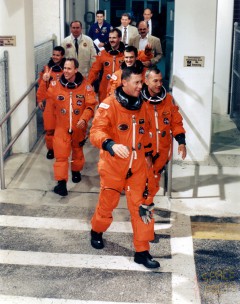
As the countdown ticked to the all-important T-31 seconds, control of the final stages was handed off from the Launch Control Center to Endeavour’s General Purpose Computers. It was they, and they alone, which would monitor hundreds of separate sensors and execute decisions as to whether the mission would fly today. The disembodied voice of the launch announcer echoed from loudspeakers, crisply acknowledging the seconds as they worked their way backwards toward the ignition of the three main engines, the ignition of the twin Solid Rocket Boosters (SRBs), and a date with a high-inclination orbit to radar-map the Home Planet for the next 10 days or so.
“12, 11, 10, nine, eight, seven … ”
At 10 seconds, the darkness was punctuated by the bright cascade of sparks from the swirling hydrogen burn igniters, as they fired off to disperse unburnt gas in the vicinity of the main engine nozzles.
“We have a Go for main engine start … ”
With a familiar rumble and a sheet of translucent orange flame, Endeavour’s three main engines thundered to life. From the roof of the Launch Control Center, several miles away, Jones’ wife, Liz, together with their two children, the other crew families, and a handful of astronaut escorts braced themselves for the upcoming crescendo of sound and vibration. “In the growing light of dawn,” Jones recalled in Skywalking, “she saw the gout of orange exhaust flare beneath the orbiter and saw the steam billow from the flame trench as the engines spooled up to full power.”
“We have three main engines running … ”
All seemed normal. Then, with shocking abruptness, something went wrong.
“Three, two, one … and … we have main engine cutoff. GLS safing is in progress.”
As the Ground Launch Sequencer automatically kicked in to “safe” the vehicle, the three blazing engine bells suddenly fell dark and silent. For the third time in less than 18 months (and only the fifth occasion in the shuttle’s operational history), a Redundant Set Launch Sequencer (RSLS) abort had been called, after engine start, producing a hazardous on-the-pad shutdown. However, whereas previous aborts had occurred at around T-3 seconds, STS-68 had gotten down to a mere 1.9 seconds ahead of liftoff. Almost immediately, cooling water was sprayed onto the hot engines and the attention of everyone in the Launch Control Center was riveted upon the Main Propulsion System (MPS) fire detectors; if any of them had tripped, the abort carried the prospects of turning into a bad day, for a invisible hydrogen fire at the base of the main engines could easily spread across the pad and trigger an explosion. And that would demand a “Mode One Egress”: a hairy evacuation of the astronauts from the orbiter to ride slidewire baskets to safety.
“We have a cutoff of the main engines. The countdown clock has stopped.”
In the seconds which followed, an urgent flurry of acronym-laden communications passed between engineers, controllers, and managers in the Launch Control Center, and with the astronauts themselves aboard Endeavour. “We have main engine cutoff … RSLS safing is in progress … All three main engines are in post-shutdown standby … GLS is Go for orbiter APU shutdown … ”
The gathered spectators at the Cape watched in horror and alarm as the famous countdown clock starkly read T-00:00:00, yet no shuttle ascended into the heavens and only a large smudge of grey cloud rose ominously above Pad 39A. Then came the call which brought a measure of calm to the proceedings: “No MPS fire detectors tripped.” There was no evidence of fire on the pad, meaning a “Mode One Egress” of the vehicle would probably be unneeded. The white room was moved back into position alongside Endeavour’s crew access hatch, to facilitate the departure of Baker and his men. Pilot Terry Wilcutt shut down the three APUs. Through Endeavour’s tiny side hatch window, Tom Jones could clearly see the Pad 39A gantry visibly swaying backwards and forwards; the vehicle was still rocking from the “twang” effect induced by the ignition of her main engines.
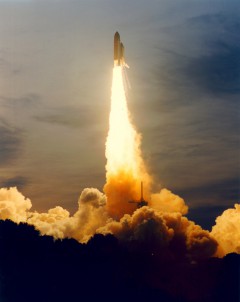
Had the engine shutdown been triggered a couple of seconds later—after SRB ignition—it would have placed the crew in an unenviable situation of having to perform the shuttle program’s first Return to Launch Site (RTLS) abort, riding the boosters for two minutes until their expiry, then separating from them and the External Tank to perform an emergency landing, back at the Kennedy Space Center. “The RTLS is a daunting prospect for the crew,” wrote Tom Jones. “We would have to fly the orbiter and attached ET through half an outside loop, then ride backward through our exhaust plume at Mach 5. Ditching the empty tank, we would then try to make it back to the Kennedy runway. No shuttle crew had ever flown such an emergency approach. None wanted to be the first to try.”
Since the Mission Management Team looked upon an RSLS in the same manner as an actual launch, the abort demanded a complete re-inspection of all main engines in the VAB engine shop and would produce a delay of approximately six weeks. Meanwhile, Dan Bursch, sitting in the flight engineer’s seat behind Commander Mike Baker and Pilot Terry Wilcutt, was even more unlucky, having also sat through the STS-51 pad abort, almost exactly a year earlier. Now, his STS-68 crewmates teased him without mercy and, according to Jones, “he lamented that no one would bother coming to another of his launch attempts.” In fact, Bursch would gain an unenviable reputation as the only astronaut to sit through two RSLS aborts in his career. In the hours and days which followed, the attention of technicians focused upon a problem with the No. 3 main engine’s High Pressure Oxidizer Turbine. One of its sensors detected a dangerously high discharge temperature, which exceeded the rules of the Launch Commit Criteria, and Endeavour’s computers halted the countdown after the Engine Start Command had been issued.
For the astronauts, it seemed their best bet of getting off the ground on 30 September was to convince Endeavour that the unlucky Dan Bursch was not aboard. As a result, when the STS-68 crew arrived at the Kennedy Space Center, a couple of days before launch, Bursch ensured that he climbed out of his T-38 jet in an appropriate “Groucho Marx” disguise. Things did not seem to be going well, for all of them, save Jeff Wisoff, had colds. In spite of the jinxed nature of their flight, 30 September turned out to be charmed, and Endeavour rose perfectly at 7:16 a.m. EDT, right on the opening of the 2.5-hour launch window. It was the last RSLS on the pad, with significant upgrades planned for the main engines in the following years … but the brutal truth was that the shuttle could never be operational or routine and would never be truly safe.
STS-55
More than seven years passed before the next RSLS abort, which came at the end of an otherwise uneventful processing flow of Columbia for STS-55, a joint U.S.-German Spacelab science mission. Shortly after arriving at the launch pad in early February 1993, an issue with tip-seal retainers on the main engines’ liquid oxygen turbopumps had come to light, necessitating their replacement, but by the morning of 22 March the astronauts and the vehicle were ready to go. The attempt to launch the mission that day proceeded smoothly, tracking a liftoff at 9:51 a.m. EDT. All seven astronauts were suited and transported to the pad, took their seats aboard the orbiter, and marched smartly through their checks. With 31 seconds remaining on the countdown clock, as planned, Columbia’s computers assumed primary control.
Six and a half seconds before liftoff, the ignition of the three main engines got underway with a low-pitched rumble. Within three seconds—dramatically, and accompanied by gasps from the assembled spectators and dignitaries—all three abruptly shut down. Subsequent analysis would point to the incomplete start of the No. 3 engine; a liquid oxygen pre-burner check valve had suffered a leak in the final seconds, causing the purge system to be pressurized above its maximum allowable limit of 50 psi. The culprit: a tiny fragment of rubber, trapped in an engine propellant valve. …
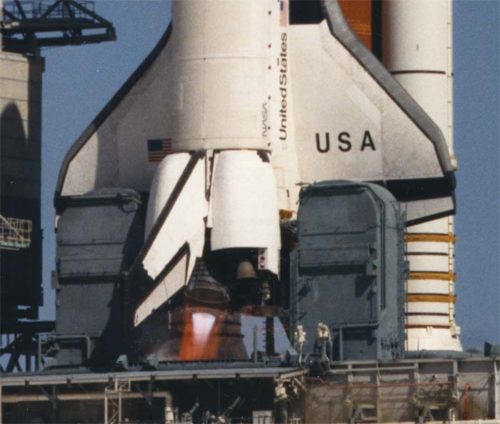
With unburnt hydrogen still lingering underneath the hot engine bells, the risk of a fire or explosion was very real. Seconds after the shutdown, the “white room” was automatically moved into position, alongside Columbia’s crew access hatch, preparatory to an evacuation. Although the astronauts had trained to escape from a pad abort and slide to a fortified bunker, the danger of having them evacuate Columbia and run through an invisible hydrogen holocaust prompted controllers to instruct them to remain aboard the orbiter. For 40 tense minutes, Commander Steve Nagel and his men remained strapped into their seats as ground personnel deactivated all electronic components. Paramedics were rushed to the pad as a precautionary measure, but for the astronauts all was well—albeit eerily still—within the swaying cabin. “I’d convinced myself,” Nagel said, “and all my crew that we were going to fly.” When the brief noise of the engines died, he called over the intercom to announce the abort to his crewmates. “I wouldn’t call it fear,” he said later about those adrenaline-charged moments. “There’s a couple of moments wondering what’s happened, because all you see on-board are red lights, indicating an engine shutdown. You know the computers shut down the engines, but you don’t know why or exactly what went wrong with them.”
The situation was equally tense in the Launch Control Center, where ashen-faced Launch Director Bob Sieck watched the proceedings. “Your initial reaction,” he said in the aftermath of the abort, “is to make sure there are no fuel leaks or that there’s nothing that’s broken that’s causing a hazardous situation. Really, it was one of those nice, boring countdowns … until the last few seconds. What did work, and worked very well, were the safety systems on-board. As a result, the crew is safe and the vehicle is on the pad and safe as well.” Nonetheless, the STS-55 crew emerged from the orbiter looking visibly shaken by the incident. It was becoming increasingly likely that a delay of at least several weeks would be needed to remove, replace, and test the engines, and on 30 March NASA announced the next shuttle mission—STS-56, a time-critical flight, scheduled for early April. In the meantime, Columbia’s engines were replaced with a set earmarked for the next mission of Endeavour, and STS-55 finally got its chance to fly on 26 April 1993.
STS-51
“T-minus 30 seconds … ”
The words of the launch commentator at the Kennedy Space Center on the morning of 12 August 1993 were calm and measured, as all eyes focused upon Space Shuttle Discovery as she entered the final portion of the countdown to fly STS-51. The mission—a nine-day flight to deploy a NASA advanced communications satellite and release and retrieve an ultraviolet telescope, atop a Shuttle Pallet Satellite, as well as perform a spacewalk—had already been postponed twice, with the astronauts already aboard the vehicle. On 17 July, a flaw in a pyrotechnic initiator controller, needed to trigger the release of the SRBs from the launch platform, had forced the first scrub. Troubleshooting later identified a thermal instability issue in a solid-state switch card in the ground support equipment, and after replacement and testing the launch was rescheduled for the following week.
“Standing by to activate the sound suppression water system in five seconds … ”
The second attempt to get Discovery into space on the 24th also proved fruitless, due to an out-of-specification turbine “underspeed” condition in a hydraulic power unit in the right-hand booster. As a result, the countdown was automatically halted at T-19 seconds and the attempt was scrubbed. Due to the July-August Perseid meteor shower, associated with Comet Swift-Tuttle, NASA decided to stand down from making a third launch attempt until the second week in August. It was known that the Perseid debris field would pass closest to Earth on the 11th, and the launch was rescheduled for 9:10 a.m. EDT the following day.
By 12 August, Discovery and her five-man crew were ready to go. The astronauts had closed and locked their visors and their eyes were focused intently on their instruments. Despite a two-and-a-half-minute hold in the countdown at T-5 minutes, due to lost synchronization lock between the Mission Control in Houston and the Merritt Island Launch Area, everything proceeded smoothly. With five minutes remaining on the countdown clock, Pilot Bill Readdy reached over and switched on the Auxiliary Power Units. The trio of hydraulic pumps hummed to life, bringing life, muscle, and control to the shuttle’s hydraulics. The shuttle’s on-board computers automatically commanded a final series of checks on the three main engines and the elevons on the wings. Thirty-one seconds before launch, control of the countdown was handed off to Discovery’s General Purpose Computers.
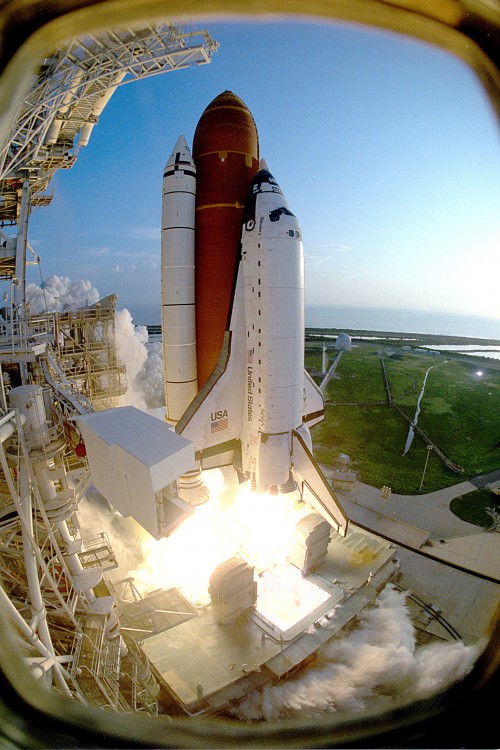
“T-minus 10, nine, eight, seven … ”
The mission for which they had spent the last 18 months training was finally about to begin. Seated at the front of the flight deck, Readdy and Commander Frank Culbertson were the only veteran members of the crew, but behind them was Mission Specialist Jim Newman, who had been a simulation supervisor before his selection as an astronaut. “Sim Sups” have long gained a measure of notoriety among astronauts, since they are responsible for introducing all manner of contingencies and failures into training exercises to keep the crews’ skills sharp. According to Tom Jones in Skywalking, Newman could not resist bringing a little of his Sim Sup expertise into astronaut candidate training. During one simulator session with Jones and legendary astronaut John Young, Newman mischievously pushed the main engine shutdown switches with his “swizzle stick.” This obliged Young to execute an abort landing in a simulated Ben Guerir, Morocco. Jones wondered what Newman was playing at. “Why would you want to kill an engine on the most senior astronaut, the first man to command the shuttle?” he wrote with incredulity. “Finally, Newman lost it; he burst out laughing as he confessed that he was the real culprit. Newman, the former instructor, had just been keeping his hand in, feeding Young one last malfunction. What surprised me was that John loved the practical joke.”
“Go for main engine start … ”
Now, on 12 August 1993, Newman was experiencing the final seconds of a countdown for real. Inside the cabin, the astronauts felt the immense vibration as turbopumps awoke, liquid oxygen and hydrogen flooded into the engines’ combustion chambers, and they roared to life … and then fell silent.
“ … Three … We have a main engine cutoff … Safing in work … ”
Abutting Newman’s left shoulder at the rear of Discovery’s flight deck was Dan Bursch, who would go on to become the only astronaut to endure two of these hair-raising aborts. The communications loop from the Launch Control Center carried a flurry of messages. As the RSLS abort was commanded, Discovery’s three main engines were verified to be in “Post-Shutdown Standby,” and Bill Readdy acknowledged the call to perform the shutdown of the orbiter’s Auxiliary Power Units. No fire detectors on Pad 39B were tripped during the incident, which would later be traced to a faulty fuel-flow sensor in Discovery’s No. 2 main engine. The engine had posted a “major component failure,” caused by the sensor glitch about 0.6 seconds after ignition. “This condition,” noted NASA’s official STS-51 Mission Report, compiled and published after the flight, “caused a miscompare which violated the Launch Commit Criteria … As a result of the failure, the engines were shut down and safing activities were initiated.”
“Orbiter access arm now back in position … ”
Shortly thereafter, the five disappointed astronauts departed Discovery, aware from previous RSLS events that their launch had been called off for several weeks at best. The main engines were replaced and an attempt was provisionally scheduled for 10 September, but this was itself slipped until the 12th. Liftoff was, recalled Jim Newman, “exhilarating,” but the RSLS had given him and his crewmates a grueling rite of passage.
From June 1984 until August 1994, five shuttle crews sat through such aborts on the pad, with Atlantis left as the only orbiter not to suffer one in her career. By the middle of the 1990s, upgraded main engines and improved processing and inspection techniques ensured that no other RSLS situations hit the program, although STS-93 in July 1999 came close to a shutdown after liftoff. The shuttle’s fallibility was evident and the dangers of the main engines remained just that—a danger—until the very end of its career.
This is part of a series of history articles, which will appear each weekend, barring any major news stories. Next week’s article will focus on the 30th anniversary of the dramatic repair of Solar Max, which tested the shuttle’s capabilities as never before in April 1984.
Want to keep up-to-date with all things space? Be sure to “Like” AmericaSpace on Facebook and follow us on Twitter: @AmericaSpace




Ben Evans has written yet another interesting and comprehensive series on the shuttle aborts. He has underscored the inherent dangers of manned space exploration. Thankfully, these aborts did not end in catastrophe and the “Mode One Egress” amd various “return to launch site” scenarios never took place. The highly-complicated shuttles were indeed “test vehicles,” never really becoming the true operational spacecraft as originally conceived. The astronauts who flew them are to be commended for their courage and dedication.
A heck of a lot of people have condemned the shuttles, for being the dangerous vehicles that they were. And of course the two shuttle accidents were among the darkest hours of space exploration, and I don’t think the wounds will ever go away. These two events will always haunt us.
But as with all things in life, things aren’t just black & white. Yes, the shuttles were inherently too unsafe and dangerous, and they never delivered on the promise of routine, reliable and safe access to space. On the other hand, people who dismiss them out of hand, tend to ignore the major breakthroughs and milestones they participated in, when it comes to space exploration. From the launch of noumerous interplanetary probes, to sattelites and space observatories, to the use of Spacelab, to the launch of the most unique telescope of all time, Hubble, that single-handindly rewrote the textbooks and changed everything that has to do with our view of the cosmos and our place in it. And of course the constant repair and upgrade it received. And of course, the shuttle participated in the biggest construction of all time in space, in the history of astronautics – the ISS.
The list of breakthroughs is long. Yet I think that the saddest part is that the shuttle was never everything that it could have been. It wasn’t allowed to. It was compromised right from the start, and its fate was sealed before it ever left the ground, when during its development, funding was constantly being diminished and NASA had to make difficult technical compromises and constant re-designs to adapt to the ever changing fiscal environment. Compromises that lead to the inevitable. As always, when it comes to space exploration, the saying holds true: ‘No bucks, no Buck Rodgers’.
And these are the same engines they want to reuse on SLS. Nice.
I was at the Cape in the viewing area on 24 August 1993 when the launch was aborted at T -19 seconds. It would prove to be my only chance to see a shuttle launch, visiting as I was from Canada. And Discovery would be the only shuttle to suffer three consecutive launch aborts in the final seconds.
The best I can do now is try to visit Discovery in its museum. Hopefully you Americans will get your act together and put your country back into the manned space program.
Ric, they are not the same engines. The SSME underwent significant safety and reliability upgrades in the late 1990s and early into the present century. After 1994 (and with the exception of STS-93), no other RSLS or major SSME malfunction was experienced during pre-flight or ascent until the very end of the Shuttle’s career in 2011. Having said that, as with all rocket engines, operating at the edge of the envelope always carries great risk.
Where can I find part 1?
Here is Part 1.
http://www.americaspace.com/?p=32859
Actually the big countdown clock during the STS-68 RSLS abort started counting up after reaching T-0. I was there and that caused some concern. It turned out that the big countdown clock was not actually tied directly into the MET circuit. That manual stop was a little slow for the STS-68 abort.
Here’s a trivia question for you…What would have happened if BFS was inadvertently engaged during an RSLS abort and the BFS GPS was not halted? Hint- it’s the reason that one of the first things that crew did was to halt the BFS after an RSLS abort.